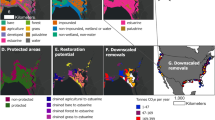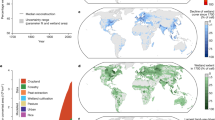Abstract
The IPCC 2013 Wetlands Supplement provided new guidance for countries on inclusion of wetlands in their National GHG Inventories. The United States has responded by including managed coastal wetlands for the first time in its 2017 GHG Inventory report along with an updated time series in the most recent 2018 submission and plans to update the time series on an annual basis as part of its yearly submission to the United Nations Framework Convention on Climate Change (UNFCCC). The United States followed IPCC Good Practice Guidance when reporting sources and sinks associated with managed coastal wetlands. Here we show that intact vegetated coastal wetlands are a net sink for GHGs. Despite robust regulation that has protected substantial stocks of carbon, the United States continues to lose coastal wetlands to development and the largest loss of wetlands to open water occurs around the Mississippi Delta due mostly to upstream changes in hydrology and sediment delivery, and oil and gas extraction. These processes create GHG emissions. By applying comprehensive Inventory reporting, scientists in the United States have identified opportunities for reducing GHG emissions through restoration of coastal wetlands that also provide many important societal co-benefits.
This is a preview of subscription content, access via your institution
Access options
Access Nature and 54 other Nature Portfolio journals
Get Nature+, our best-value online-access subscription
$29.99 / 30 days
cancel any time
Subscribe to this journal
Receive 12 print issues and online access
$209.00 per year
only $17.42 per issue
Buy this article
- Purchase on Springer Link
- Instant access to full article PDF
Prices may be subject to local taxes which are calculated during checkout
Similar content being viewed by others
References
IPCC Good Practice Guidance for Land Use, Land-Use Change and Forestry (eds Pennman, J. et al.) (IGES, 2003).
Houghton, J. T. et al. (eds) Revised 1996 IPCC Guidelines for National Greenhouse Gas Inventories (IPCC, 1997).
The Good Practice Guidance and Uncertainty Management in National Greenhouse Gas Inventories (IPCC, 2000).
2013 Supplement to the 2006 IPCC Guidelines for National Greenhouse Gas Inventories: Wetlands (eds Hiraishi, T. et al.) (IPCC, 2014).
Inventory of U.S. Greenhouse Gas Emissions and Sinks: 1990-2015 (US EPA, 2017); https://www.epa.gov/ghgemissions/inventory-us-greenhouse-gas-emissions-and-sinks-1990-2015
Inventory of U.S. Greenhouse Gas Emissions and Sinks: 1990-2016 (US EPA, 2018); https://www.epa.gov/ghgemissions/inventory-us-greenhouse-gas-emissions-and-sinks-1990-2016
Poffenbarger, H. J., Needelman, B. A. & Megonigal, J. P. Salinity influence on methane emissions from tidal marshes. Wetlands 31, 831–842 (2011).
Dahl, T. E. & Stedman, S. M. Status and Trends of Wetlands in the Coastal Watersheds of the Conterminous United States 2004 to 2009 (US Department of the Interior, Fish and Wildlife Service and National Oceanic and Atmospheric Administration, National Marine Fisheries Service, 2013).
Kennish, M. J. Coastal salt marsh systems in the U.S.: a review of anthropogenic impacts. J. Coast. Res. 17, 731–748 (2001).
Olea, R. A. & Coleman, J. L.Jr. A synoptic examination of causes of land loss in southern Louisiana as related to the exploitation of subsurface geologic resources. J. Coast. Res. 30, 1025–1044 (2014).
Twilley, R. R. et al. Co-evolution of wetland landscapes, flooding, and human settlement in the Mississippi River Delta Plain. Sustain. Sci. 11, 711–731 (2016).
Syvitski, J. P. M. et al. Sinking deltas due to human activities. Nat. Geosci. 2, 681–686 (2009).
Blair, N. E. & Aller, R. C. The fate of terrestrial organic carbon in the marine environment. Annu. Rev. Mar. Sci. 4, 401–423 (2012).
GFOI Integrating Remote-Sensing and Ground-Based Observations for Estimation of Emissions and Removals of Greenhouse Gases in Forests: Methods and Guidance from the Global Forest Observations Initiative (Group on Earth Observations, 2013).
Schuerch, M. et al. Future response of global coastal wetlands to sea-level rise. Nature 561, 231–234 (2018).
Visser, J. M., Duke-Sylvester, S. M., Carter, J. & Broussard, W. P. A computer model to forecast wetland vegetation changes resulting from restoration and protection in coastal Louisiana. J. Coast. Res. 67, 51–59 (2013).
Kroeger, K. D., Crooks, S., Moseman-Valtierra, S. & Tang, J. W. Restoring tides to reduce methane emissions in impounded wetlands: a new and potent blue carbon climate change intervention. Sci. Rep. 7, 11914 (2017).
Couvillion, B. R., Steyer, G. D., Wang, H. Q., Beck, H. J. & Rybczyk, J. M. Forecasting the effects of coastal protection and restoration projects on wetland morphology in coastal Louisiana under multiple environmental uncertainty scenarios. J. Coast. Res. 67, 29–50 (2013).
DeLaune, R. D. & White, J. R. Will coastal wetlands continue to sequester carbon in response to an increase in global sea level?: A case study of the rapidly subsiding Mississippi River deltaic plain. Climatic Change 110, 297–314 (2012).
IPCC Climate Change 2007: The Physical Science Basis (eds Solomon, S. et al.) (Cambridge Univ. Press, 2007).
Lowther, A. & Liddel, M. (eds) Fisheries of the United States 2015 (National Marine Fisheries Service, 2015); https://www.st.nmfs.noaa.gov/commercial-fisheries/fus/fus15/index
Acknowledgements
We are grateful to the Coastal Blue Carbon Working Group, Restore America’s Estuaries, the NOAA, the USGCRP and the EPA for support and technical input as part of this process. This is contribution number 9 of the Sea Level Solutions Center at the Institute of Water and Environment, Florida International University.
Competing interests
The authors declare no competing interests.
Author information
Authors and Affiliations
Contributions
S.C. and T.G.T. led the process for including coastal wetlands in the US Greenhouse Gas Inventory with technical input from T.W. and with help from A.E.S.-G., N.H., B.B. and L.S.-B. S.C., A.E.S.-G. and T.G.T. wrote this manuscript with help from T.W.
Corresponding author
Additional information
Publisher’s note: Springer Nature remains neutral with regard to jurisdictional claims in published maps and institutional affiliations.
Supplementary information
Supplementary Information
Supplementary Discussion, Supplementary Tables 1–2, Supplementary References
Rights and permissions
About this article
Cite this article
Crooks, S., Sutton-Grier, A.E., Troxler, T.G. et al. Coastal wetland management as a contribution to the US National Greenhouse Gas Inventory. Nature Clim Change 8, 1109–1112 (2018). https://doi.org/10.1038/s41558-018-0345-0
Received:
Accepted:
Published:
Issue Date:
DOI: https://doi.org/10.1038/s41558-018-0345-0
This article is cited by
-
Mapping methane reduction potential of tidal wetland restoration in the United States
Communications Earth & Environment (2023)
-
A 1.2 Billion Pixel Human-Labeled Dataset for Data-Driven Classification of Coastal Environments
Scientific Data (2023)
-
Forecasting Sea Level Rise-driven Inundation in Diked and Tidally Restricted Coastal Lowlands
Estuaries and Coasts (2023)
-
Numerical modeling of wave attenuation: implications of representing vegetation found in coastal saltmarshes in the Chesapeake Bay
Environmental Monitoring and Assessment (2023)
-
Plant species determine tidal wetland methane response to sea level rise
Nature Communications (2020)



